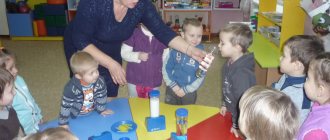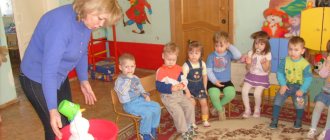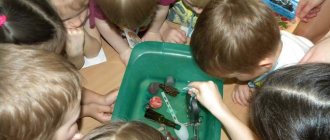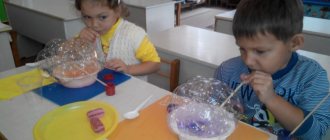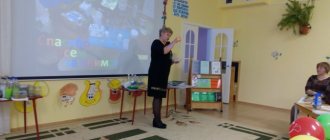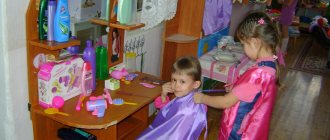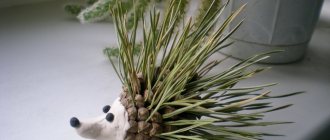Children's experimental activities - presentation
Experimental activities of children Learning should not only be useful, but also interesting, it should shape a person’s worldview, develop curiosity and erudition in him.
I cope with this task very well by organizing experimental work with preschoolers. A preschool child is an inquisitive, thinking, observing person. Exploring the world, he makes many discoveries. Experimentation is an effective means of intellectual development of preschool children. Any child is constantly involved in it: he tears paper, takes apart toys, plays with sand, water and snow.
The teacher’s task is to help the preschooler conduct research, make it useful and safe for the child and his environment. Therefore, exploratory behavior for a preschooler is the main source of gaining ideas about the world.
In my work, I widely use experimental activities of preschoolers. The group has a mini-laboratory
They present a subject development environment for research: magnifying glasses, measuring cups, funnels, pipettes, test tubes, a telescopic cup, lenses, magnets, colored glasses, etc.
Experiments with paper While getting acquainted with the properties of paper, the children notice that the paper is torn. Depending on its thickness, it can be wrinkled and become wet in water.
Experiments with fabric Fabric consists of threads, wrinkles, and is easy to wash and iron.
Invisible air Experiments with air are very interesting and fascinating, since it is not visible. Children fill plastic bags and balloons with air and notice that they become dense and elastic.
Blow through a tube onto the surface of the water, causing waves and bubbles to form.
And if you blow on a small object through a tube, it will begin to move.
Water Sorceress Children pour water into different containers and understand that water has no shape, color, or smell.
I really like the game “Floats and sinks”
Experiments with a magnet In an exciting game, children can get acquainted with the properties of a magnet in practice. Find objects that interact with a magnet; determine materials that are not attracted to a magnet. The following task maintains interest: remove a paperclip from the water without getting your hands wet.
Thus, targeted, systematic experimental work with preschoolers allows us to identify and shape children’s need for constant cognitive activity, maintain interest and promote comprehensive development.
Experimental research activities in preschool educational institutions Educator: Pshenichnikova T.N. - presentation
Experimental research activities in preschool educational institutions Educator: Pshenichnikova T.N.
Children's experimentation is one of the methods of teaching and developing the natural science concepts of preschoolers. In the course of experimental activities, the preschooler learns to observe, think, compare, answer questions, draw conclusions, establish a cause-and-effect relationship, and follow safety rules.
GOAL Deepening understanding of living and inanimate nature; the ability to independently conduct research, achieve results, reflect, defend one’s opinion, and generalize the results of experiments.
In the process of organizing experimental activities, the following tasks are solved: developing the ability to see the diversity of the world in a system of interrelations; involving children in thinking, modeling and transformative activities; enrichment); expanding prospects for the development of search and cognitive activity, maintaining children’s initiative, intelligence, inquisitiveness, criticality, independence, visual aids (standards, symbols)
One of the conditions for solving problems in experimental activities in kindergarten is the organization of a developmental environment. The object environment surrounds and influences the child from the first minutes of his life. The main requirements for the environment as a developmental tool are to ensure the development of active independent children's activities.
SUBJECT-DEVELOPMENT ENVIRONMENT
Stones and minerals
Seeds
Plants
Experiments and experiences The most interesting experiments for children are experiments. Experiments are like magic tricks. Only the mystery of the tricks will remain unsolved, but everything that results from experiments can be explained and understood. Experiments help develop a child’s thinking, logic, and creativity, and clearly show the connections between living and nonliving things in nature. Research provides the child with the opportunity to find answers to the questions “how?” and why?"
It flies down in droplets, and up - invisible. Experiments with water
Experiments with snow
Experiments with plants
Experiments with sand and clay
In the process of experimentation, children learn: -See and identify a problem. -Accept and set goals. -Solve problems. -Analyze the object and phenomena. -Identify essential features and connections. -Select tools and materials for independent activities. -Carry out an experiment. -Put forward hypotheses and proposals. -Draw conclusions.
“People who have learned to observe and experiment acquire the ability to pose questions themselves and receive factual answers to them, finding themselves at a higher mental and moral level in comparison with those who have not gone through such a school” K. A. Timiryazev
THANK YOU FOR YOUR ATTENTION!
